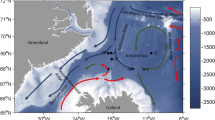Abstract
Day/night zooplankton sampling in Kosterfjorden, Sweden, gave information on population succession, vertical distribution and feeding of Calanus finmarchicus over 17 months. Copepodid Stage 1 and 2 (C-I, C-II) were present from December to August, indicating reproduction during most of the year. Mating and breeding for the overwintering generation mainly took place in February/March, resulting in peak abundance of C-I in March/April. Secondary breeding periods were in April and July/August, but the resulting recruitment from these were low. The relative recruitment success in the first spring was around 13 times higher than during the second spring. Low temperature in the surface water early in the year and depression of the spring phytoplankton bloom may have caused the failure in the second year. Population biomass peaked at >15 g dry weight m−2 during the numeric peak of the youngest stages in March/April. A more sustainable level of high biomass of 8 to 10 g dw m−2 was gradually built up during summer, mainly due to a continuous accumulation of C-Vs. Adults and C-Vs comprised the overwintering population, with 7 to 14% and 85 to 93%, respectively, for the 2 years, but only C-Vs staying in the deep water were in a resting state. Adult males showed a strong diurnal vertical migration (DVM) of the usual type from spring to early autumn and a reversed DVM during the cold season. They were in a feeding state throughout the year. Adult females showed the usual type of DVM during summer to autumn, but commonly a reversed DVM during winter to spring. They were usually in a feeding state, with no pronounced differences between surface and deep water or between day and night. C-Vs aggregated in the deep water from October to March and performed DVM in April to June. They were commonly feeding in the deep water between March and June but showed no or very low feeding activity there from July to February. C-Vs in the surface water were commonly feeding and showed the highest proportion of feeding in autumn, when the population in the deep water was inactive. C-V constituted up to nearly 100% of the population biomass, and therefore must be of profound ecological importance. Defined by this dominant role, the population of C. finmarchicus can be characterised as having an active period of feeding, reproduction and development from February to July with a following 6 to 7 months of resting in the deep water, when development is arrested and no feeding occurs.
Similar content being viewed by others
Author information
Authors and Affiliations
Additional information
Received: 1 October 1999 / Accepted: 27 April 2000
Rights and permissions
About this article
Cite this article
Båmstedt, U. Life cycle, seasonal vertical distribution and feeding of Calanus finmarchicus in Skagerrak coastal water. Marine Biology 137, 279–289 (2000). https://doi.org/10.1007/s002270000337
Issue Date:
DOI: https://doi.org/10.1007/s002270000337



